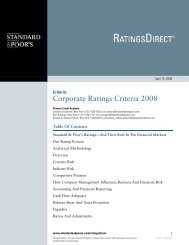European Infrastructure Finance Yearbook - Investing In Bonds ...
European Infrastructure Finance Yearbook - Investing In Bonds ...
European Infrastructure Finance Yearbook - Investing In Bonds ...
Create successful ePaper yourself
Turn your PDF publications into a flip-book with our unique Google optimized e-Paper software.
Publication Date:<br />
June 7, 2007<br />
Issuer Credit Rating:<br />
A/Negative/A-1<br />
Primary Credit Analyst:<br />
Alexandre de Lestrange,<br />
Paris,<br />
(33) 1-4420-7316<br />
Secondary Credit Analyst:<br />
Lidia Polakovic,<br />
London,<br />
(44) 20-7176-3985<br />
SANEF<br />
Rationale<br />
The ratings on Sanef are equalized with those on<br />
Abertis <strong>In</strong>fraestructuras S.A. (A/Negative/--).<br />
Following its privatization, Sanef is controlled by<br />
Abertis through 52.6%-owned Holding<br />
d’<strong><strong>In</strong>frastructure</strong>s de Transport S.A.S. (HIT;<br />
A/Negative/--), the intermediary vehicle that<br />
acquired Sanef.<br />
The rating on Abertis reflects the company’s<br />
excellent business profile, with strong and stable<br />
cash flow generation derived largely from its tollroad<br />
concession business, a supportive regulatory<br />
framework both in Spain and France, and fairly<br />
manageable future capital-expenditure needs.<br />
These strengths are offset by Abertis’ weakened<br />
financial profile and lack of dividend flexibility, as<br />
well as its appetite for additional acquisitions,<br />
which could further impair its business and<br />
financial profile. It is important to note that<br />
without this support, HIT and Sanef’s underlying<br />
credit quality would be significantly weaker. On a<br />
combined, stand-alone basis, HIT and Sanef<br />
would have very low investment-grade ratings. If<br />
Abertis’ continued acquisitive strategy<br />
significantly reduces Sanef’s contribution to<br />
Abertis’ consolidated financial profile, HIT and<br />
Sanef could be rated one notch below Abertis.<br />
The ratings on Sanef reflect its strong market<br />
position as the third-largest interconnected tollroad<br />
network across key economic and tourist<br />
corridors in France, supportive concession<br />
agreements, high profitability, and increasing<br />
positive free cash flow generation. These strengths<br />
are offset by Sanef’s exposure to traffic risk, a<br />
weakened financial profile following its<br />
acquisition by HIT--particularly when HIT’s debt<br />
is factored in--and aggressive dividend payout to<br />
HIT limiting debt burden curtailment and<br />
exposing lenders to substantial refinancing risk.<br />
<strong>In</strong> the financial year ended Dec. 31, 2006,<br />
Sanef’s consolidated EBITDA amounted to €809<br />
million, up 8.6% on 2005. EBITDA essentially<br />
derived from toll revenues, which grew 6% in<br />
2006, and should continue to represent 90% or<br />
more of revenues over the medium term. The<br />
unadjusted EBITDA margin increased to 66%.<br />
Consolidated HIT and Sanef net debt peaked at<br />
about €6.8 billion (excluding Sanef’s debt<br />
revaluation following acquisition), in line with<br />
expectations, at year-end 2006. With a<br />
STANDARD & POOR’S EUROPEAN INFRASTRUCTURE FINANCE YEARBOOK<br />
TRANSPORTATION INFRASTRUCTURE<br />
consolidated net-debt-to-EBITDA ratio of 8.7x,<br />
the companies were still comfortably complying<br />
with the consolidated covenants at HIT’s level<br />
(maximum ratio of 10.5x) at year-end 2006.<br />
Based on the consolidated covenants at the HIT<br />
level, leverage is expected to decrease to 6.5x at<br />
year-end 2012. Sanef’s group net debt at 5.2x<br />
EBITDA at year-end 2006 is still well below the<br />
threshold of 7.0x set by Caisse Nationale des<br />
Autoroutes (AAA/Stable/--).<br />
Liquidity<br />
Sanef’s liquidity is satisfactory, owing to steady<br />
cash flow generation stemming from the tollroad<br />
business.<br />
Financing needs for 2007 include some €469<br />
million of debt maturing until Dec. 31, 2007, and<br />
a forecast €176 million dividend payment to HIT<br />
based on 100% payout of 2006 net income.<br />
These were partially covered by available cash<br />
and marketable securities of €223 million at yearend<br />
2006 and expected positive free operating<br />
cash flow (defined as funds from operations<br />
{FFO} plus working capital change, minus capital<br />
expenditures) of about €280 million in 2007,<br />
making debt refinancing necessary.<br />
Outlook<br />
The negative outlook mirrors that on Abertis and<br />
reflects mainly our concern that Abertis is now<br />
pursuing a more aggressive acquisition strategy<br />
following the purchase of a 32% stake in Eutelsat<br />
Communication S.A. (BB+/Stable/B), the holding<br />
company of Eutelsat S.A.<br />
We expect Abertis to be able to meet the target<br />
ratios we indicated on June 1, 2006: FFO to gross<br />
debt of about 13%-15% and FFO interest<br />
coverage of about 3.5x-4x. We expect Abertis to<br />
approach the lower end of these ranges over the<br />
next two years, and to make continued<br />
improvements toward the higher end of the<br />
ranges thereafter.<br />
Abertis does not have headroom for further<br />
debt-financed acquisitions at the current rating<br />
level. A stronger-than-originally-expected financial<br />
performance could lead to a revision of the<br />
outlook to stable on Abertis, and therefore on<br />
Sanef and HIT. ■<br />
NOVEMBER 2007 ■ 89



